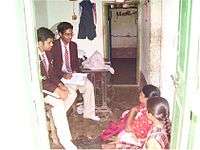Socially Useful Productive Work
Socially Useful Productive Work (SUPW) is a "parposive productive work and services realted to the needs of the child and the community will be proved meaningful to the learner. such work must not be performed mechanically but must include plannin, analysis and detailed preparation, at every stage so that it is educational in essence. Adoption of improved tools and materials, where availabel and the adoption of modern techniques will lead to an appreciation of the needs of a progressive society based on technology." Students learn to work as a team and to work with skill and deftness. It was introduced in 1978, by the Ministry of Education to promote Gandhian values and educational ideas of Mahatma Gandhi.[1]

It remains an ancillary, but mandatory part of course curriculum in schools affiliated to the Council for the Indian School Certificate Examinations (CISCE),[2] which conducts two examinations in India: the Indian Certificate of Secondary Education (ICSE) and the Indian School Certificate (ISC). It is taught in some Central Board of Secondary Education (CBSE) schools, which includes Kendriya Vidyalaya and Jawahar Navodaya Vidyalaya schools.
In addition to developing individual skills, SUPW aims to help develop among the students the habit to work as a community, encourage community thinking, increase awareness of scientific advancements and develop a scientific outlook. The training acquired in the classroom is expected to help students to solve day-to-day problems of the community.
In some schools of India game subjects like Yoga, Cricket, swimming,chess,table tennis,basketball,athletes,football,dance,music are also a choice. In some schools SUPW period start from 6th and 7th class onwards
History
meaningful manual work, resulting in either goods or services
- Report of Review Committee, 1977[1]
Recommending education through craft, Mahatma Gandhi said, "..The core of my suggestion is that handicrafts are taught not merely for production work but for developing intellect of the pupils".[3] This idea was taken forward by the Kothari Commission (1964–66), which suggested introduction of 'work experience' in education. Subsequently, after the recommendations of 'Ishwarbhai Patel Committee' (July, 1977), which first coined the term 'Socially Useful Productive Work' or SUPW, the subject was first introduced to the school curriculum in 1978, by Ministry of Education, Government of India.[4]
Crafts and hobbies
As per the " Programme of Action of the National Policy on Education of 1986",which emphasis promotion of culture and creativity in school children, SUPW curriculum may also include, Pottery, Clay Modelling, Paper Mache, Mask Making, Tie & Dye, Rangoli, Wall decoration, Cane work, Bamboo work, Book binding, Paper toys,etc.[2][5][6]
Further reading
- A Text Book of SUPW, Vol. 1, by Juhi Aggarwal. Pitambar Publishing, 2005. ISBN 8120908538.
- Position Paper: Work and Education NCERT, January 2007.
References
- Krishnamurthy , p. 20
- "Socially Useful Productive Work And Community Service: Classes IX-X" (PDF). Council for the Indian School Certificate Examinations (CISCE). Archived from the original (PDF) on 11 May 2013. Retrieved 16 February 2015.
- Kochhar, p. 147
- "The Education quarterly, Volume 30". Ministry of Education & Social Welfare. 1978. p. 25. Missing or empty
|url=(help) - "Socially Useful Productive Work/Work Experience" (PDF). Centre for Cultural Resources and Training (CCRT).
- "New initiative to train school children". The Economic Times. Sep 29, 2002.
Additional sources
- Socially Useful Productive Work Board of Secondary Education, Madhya Pradesh
- S. K. Kochhar (1984). "12: Socially Useful Productive Work (SUPW) in Education". Pivotal Issues In Indian Education. Sterling Publishers Pvt. Ltd. ISBN 8120700732.
- A G Krishnamurthy (2007). "3. SUPW: The Concept and its Implications". Work Experience Education. Diamond Pocket Books (P) Ltd. ISBN 8128812114.
- Tarun Rashtriya (2008). "Work Experience and SUPW". Vocational Education. APH Publishing. p. 85. ISBN 817648864X.
External links
- "Socially Useful Productive Work And Community Service: Classes IX-X" (PDF). Council for the Indian School Certificate Examinations (CISCE). Archived from the original (PDF) on 11 May 2013. Retrieved 16 February 2015.